23+ Sample SWOT Analysis Worksheet
-

Personal SWOT Analysis Worksheet
download now -
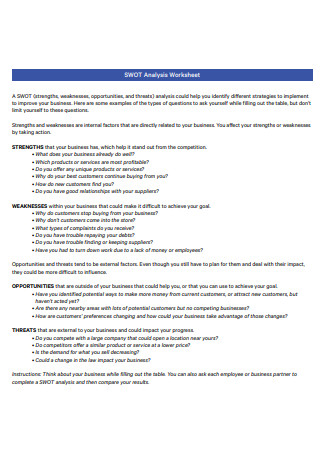
SWOT Analysis Worksheet Template
download now -
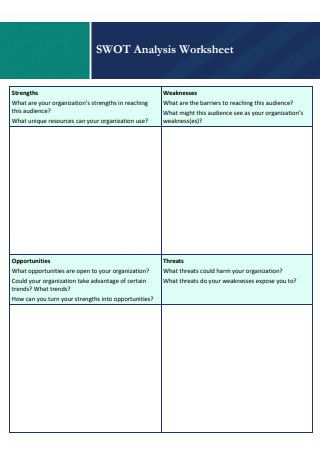
Sample SWOT Analysis Worksheet
download now -
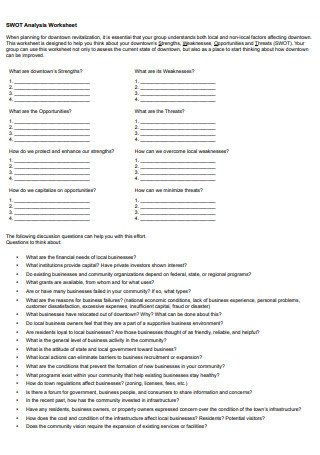
Basic SWOT Analysis Worksheet
download now -
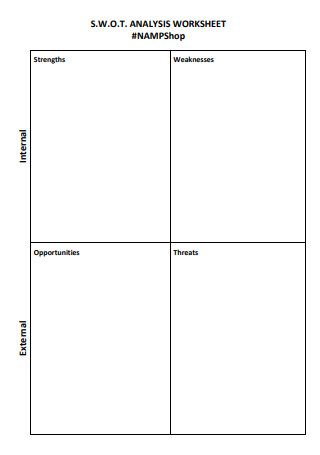
SWOT Analysis Worksheet Example
download now -

Standard SWOT Analysis Worksheet
download now -
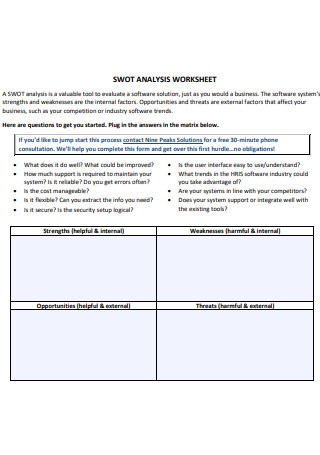
SWOT Analysis Worksheet in PDF
download now -
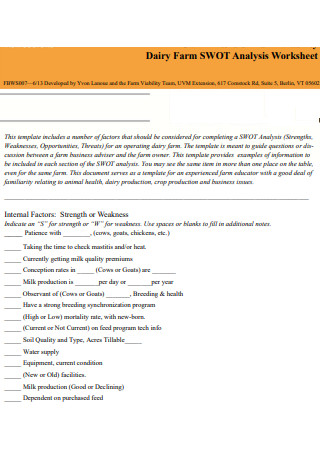
Dairy Farm SWOT Analysis Worksheet
download now -
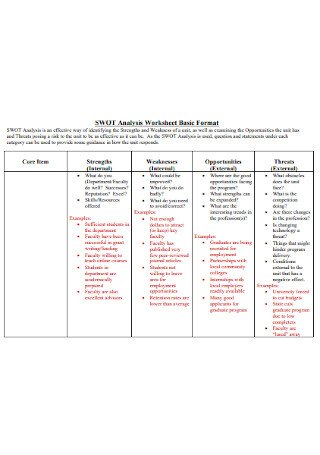
SWOT Analysis Worksheet Format
download now -
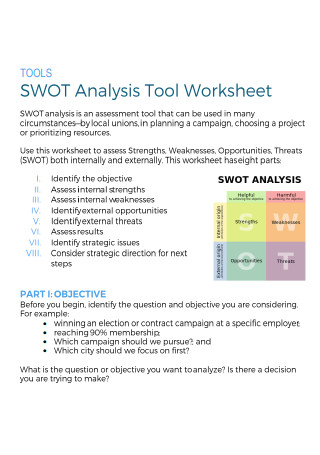
SWOT Analysis Tool Worksheet
download now -

Simple SWOT Analysis Worksheet
download now -
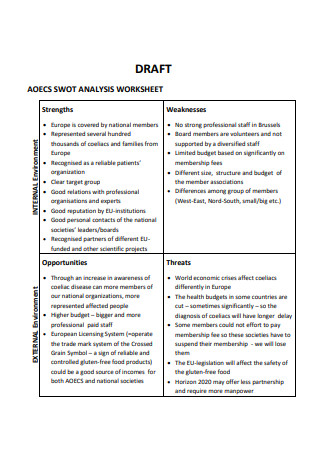
Draft SWOT Analysis Worksheet
download now -

Research Business SWOT Analysis Worksheet
download now -
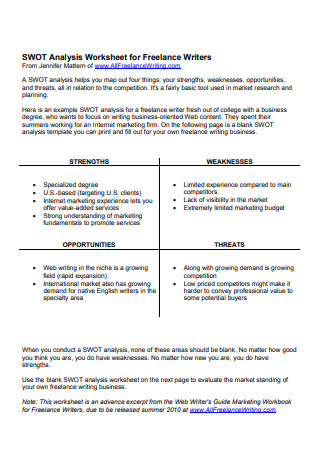
SWOT Analysis Worksheet for Freelance Writers
download now -
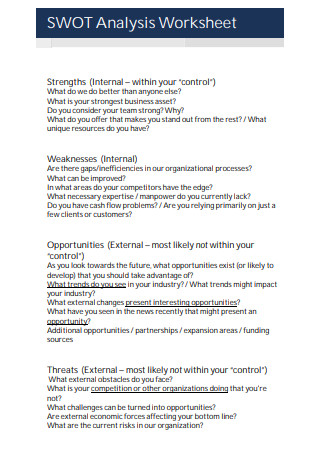
Printable SWOT Analysis Worksheet
download now -
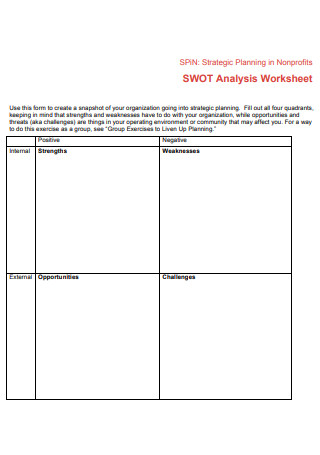
Non Profits SWOT Analysis Worksheet
download now -

Department SWOT Analysis Worksheet
download now -
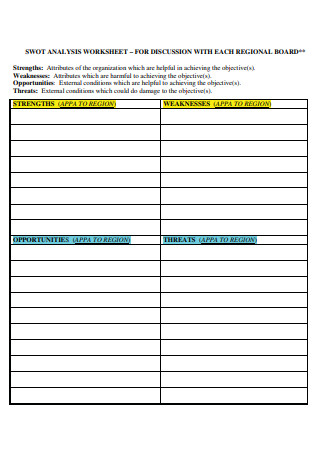
Regional Board SWOT Analysis Worksheet
download now -

Group Discussion SWOT Analysis Worksheet
download now -

SWOT Analysis Worksheet Tool and Resources
download now -
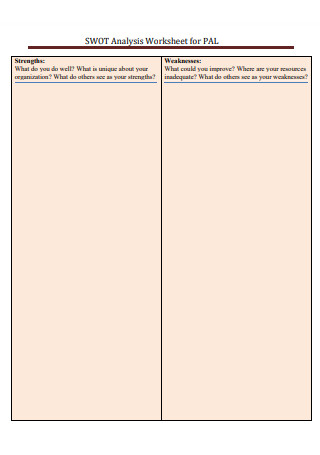
SWOT Analysis Blank Worksheet
download now -
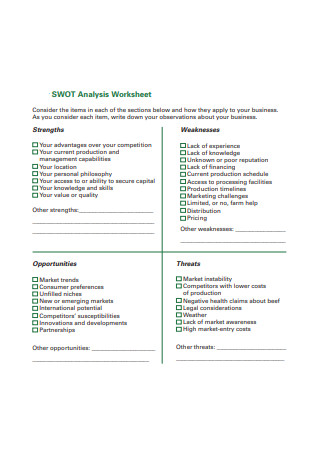
Business SWOT Analysis Worksheet
download now -
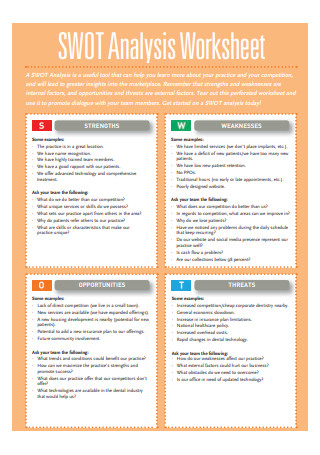
Team Members SWOT Analysis Worksheet
download now -
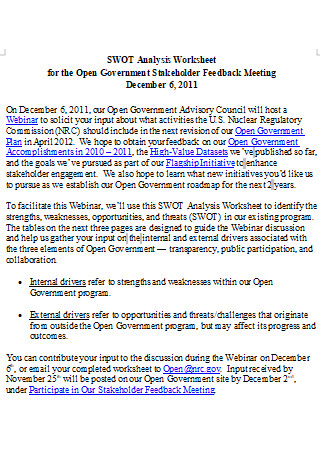
SWOT Analysis Worksheet in DOC
download now
FREE SWOT Analysis Worksheet s to Download
23+ Sample SWOT Analysis Worksheet
What Is a SWOT Analysis Worksheet?
When to Use a SWOT Analysis Worksheet?
Key Elements Included in a SWOT Analysis Worksheet
Benefits of a SWOT Analysis Worksheet
Step by Step Process in Creating a SWOT Analysis Worksheet
SWOT Analysis to TOWS Analysis
What Is a SWOT Analysis Worksheet?
A SWOT analysis is a means to assess the different internal and external factors of a business or an individual project. This is a tool most commonly used in strategic planning. This will identify whether the project or business is going well and is able to meet the expected deliverables.
This document will contain various aspects that are completely related with the business venture or an individual project. They can be classified as internal factors and external factors. However, they will be divided into 4 different categories. SWOT stands for strengths, weaknesses, opportunities and threats.
When to Use a SWOT Analysis Worksheet?
This is used primarily to aid you in making tough decisions. This can also be used in looking for recommendations about a project. Understanding the opportunities and threats will allow the user to be prepared for what is to come. In case of risks arising in the middle of the project, This will be a useful instrument to identify the next course of action as well as adjust the operational plans.
This is also an essential document in order to determine your weaknesses. Upon identification of the shortcomings, this will give you the means to assess the problem and an opportunity for you to solve it. Knowing what aspect and factor you have advantage on will be useful. If you choose to capitalize on those strengths, this will bring about an increase in the chances of success.
A SWOT analysis is usually used before entering a new industry or business. It is also used in determining whether a particular project would bring about success. A SWOT analysis may be used in all aspects of your personal life as well as professional career. This will help in identifying what is going well for you as well as what needs to be changed.
Key Elements Included in a SWOT Analysis Worksheet
Benefits of a SWOT Analysis Worksheet
Identification of Unknown Factors
More often than not, with the use of this analysis, you are bound to discover new factors. The conductor of the analysis will discover hidden strengths and uniqueness that other competitors do not have. Also, this will allow the project managers to identify underlying threats that are likely to arise in the near future.
Alignment of Strategies
With the goal of the project provided, the leader as well as the team member will be able to come up with a strategy that is both beneficial for them. This means that everyone will understand their roles and responsibilities clearly.
Improvement of Focus
This will help in keeping the team together. With everyone knowing the strengths and weaknesses as well as the different opportunities and threats, all the employees will be on the same page and work towards one goal.
Step by Step Process in Creating a SWOT Analysis Worksheet
Step 1: Choose a Template
First and foremost, browse all the available templates above and choose one of your liking. Creating a SWOT analysis with the help of a template will make the process easier and more organized. There will be no need to start from scratch.
Step 2: Designate the Leader
The next step would be to identify the team leader. Who will be the one in charge of conducting the SWOT analysis? The team leader is also the one in charge of monitoring the activities as well as the milestones and keeping track of the records. They should also be the one responsible for allocating each team member to their designated position and work.
Step 3: Identify the Specific Goals
Next step is to identify what will be assessed. Will it be the entire business organization or a particular project within the organization? This is the question you need to answer first. Upon identifying the target that will be evaluated, it is a must to dig deep and determine the specific goals. For easier and better assessment, make sure that the set of goals and objectives of a company or a project falls under each category of a SMART goal.
Step 4: Identify the Internal Factors
It is a good idea to identify the factors or elements that are affecting the company from within first. What are the internal factors that greatly impact the operation as well as the schedule of the project? What are the internal factors that contribute to the overall success of the project? What are the factors that hinders or slows down the schedule of the project? In identifying the internal factors, divide them up into positive and negative. The positive factors will be listed down on the section for strengths. On the other hand, the section for weaknesses will be purely for negative aspects.
Tips in identifying the positive internal factors are:
- Company characteristics that distinguish you from other competitors
- Internal resources such as key staff that is a cut above from the rest
- What does your company has access to that other competitors do not have?
Overall this will determine the things that your company excels on. On the other hand, the tips that help in identifying the negative internal factors are:
- Resources your company or project has that are limited
- Business and marketing plans that are cliché and unclear
- What do other competitors have access that your company does not have?
Overall the internal negative factors will be made up of aspects and factors that your company lacks or that the other competitors excels on.
Step 5: Identify the External Factors
It is also a must to identify the factors from outside the boundaries of the business organization. These will determine the factors that your employees or the higher ups have no control over. These will then be divided into two categories. The opportunities are the external factors that will bring about positive change in the company. On the other hand, the threats are the external factors that will bring about negative impacts in the company or the project.
What to consider as positive external factors or opportunities?
- What is the current direction of the market that your company can be advantageous at?
- Are there any changes in the social lifestyle in your target audience that your business may capitalize on?
- Is the demand for your goods and services expected to increase in the next few months or so?
Simply put, the opportunities will be all the aspects and factors outside of your company that will shift the advantage in your favor.
What to consider as negative external factors or threats?
- What are hurdles or obstructions that your company is experiencing?
- Is the market expected to shift in a direction that will cause a huge disadvantage for your company?
- Is the industry your company belongs to facing an issue?
Simply put, the threats will be made up of all the aspects and factors outside your business organization that will be disadvantageous to you.
The external variables that usually dictate the opportunities and threats of a business organization is the customer along with the market trend. Other factors consist of competitors, suppliers and the environment.
Step 6: Regular Assessment
Upon conducting the SWOT analysis, it is important to make sure that you have access to it. Constant monitoring of the different internal and external factors is crucial. A SWOT analysis is a dynamic document. This means that it needs to be reviewed and updated every time there are changes in the market or industry. This is done in order to make sure that the document is able to keep up with the bare minimum. It is important to make sure that the document is up with the standards of the business organization or a project.
SWOT Analysis to TOWS Analysis
It is not enough that you identify the different strengths, weaknesses, opportunities and threats that a company or a project possess. It is also important to make use of those pieces of information and convert them into doable plans of action. A TOWS analysis is a variation of SWOT analysis that aims to connect the internal factors with the external factors. This is done in order to come up with various strategies.
Strengths and Opportunities
The first is to connect both positive factors and come up with a course of action that will utilize those strengths in order to seize opportunities.
Strengths and Threats
The next strategy is to make use of the identified strengths in order to mitigate the threats. Simply put, this will assist the formulation of risk management plan.
Weaknesses and Opportunities
The third one aims to identify a plan of action that will minimize the weaknesses by the means of capitalizing on opportunities.
Weaknesses and Threats
The last combination will come up with a strategy that will minimize weaknesses and mitigate the threats.
A SWOT analysis is a combination of 4 different aspects. They are strengths, weaknesses, opportunities and threats. Upon identification of these 4 factors, the user will have the means to identify the internal and external factors that will positively and negatively impact the business organization or the project. Browse the templates above and utilize one in order to have a guide in creating this document.
